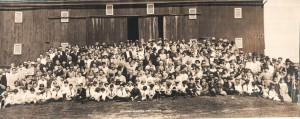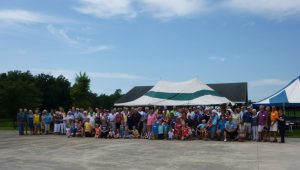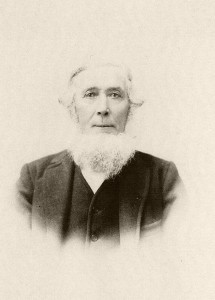We have two family reunions coming up very soon, my paternal and maternal family reunions. Many families do not have reunions anymore, but both sides of my family, the Millers and the Schumms, have reunions regularly. How special is that.
The Miller reunion is this weekend and the Schumm reunion is the following weekend.
The Miller reunion is the smaller of the two reunions, attended by the descendants of my paternal grandparents, Carl and Gertrude (Brewster) Miller, both born in 1896. About 45-50 people attend and it is the same weekend every year. It is basically an unstructured, but enjoyable, reunion. We gather for a pot-luck noon meal, overeat the delicious food, and spend the afternoon visiting, sometimes looking at old photos and taking new family photos. The first families to show up set up tables and chairs and the last to leave do a little clean up and put the tables and chairs back. Not a whole lot of planning is involved.

Miller reunion, c1958.
We have had a Miller reunion for about as long as I can remember, probably at least 65 years. In the early years the Miller reunion revolved around the Brewster reunion. My Aunt Ruth’s family would come from Pennsylvania and stay a whole week and attended both reunions. My cousin Linda would stay with my mom and dad and me. That was back in the late 50s. At first the Millers gathered at grandpa and grandma Miller’s house, then sometimes at Aunt Kate’s or at Aunt Em’s, then many years at the park at Berne, then the park at Willshire, and now we meet at a fellowship hall at a church in Berne.
We have had at least 65 Millers reunions.
In that respect, the Miller reunion beats the Schumm reunion.
This year’s Schumm reunion will their 45th. The first Schumm reunion was held 10 August 1924, making this year the 100th year anniversary of the reunion. With a few exceptions, the Schumm reunion is held every other year and that is why they have had fewer reunions.

The first Schumm Reunion, 1924, at the Schumm homestead.
The Schumm reunion is for the descendants of John George Schumm (1777-1846) who immigrated to America in 1833. Their reunion goes back much farther than the Miller reunion and because of that, the Schumm reunion is much larger.
The first Schumm reunion was held at the original Schumm homestead, west of the church, and was held there for many years, until the old Schumm barn was razed. After that, their reunions were held at the farm across the road from the church, which at that time was the Ned Alspaugh farm. Now reunions are held at the pavilion at the church.
Usually about 150-200 family members attend the Schumm reunion. Their reunion is held the same weekend every-other year. The day begins with a church service, followed by a delicious carry-in dinner, followed by a program, business meeting, some singing, and a reunion photo is taken.
This all takes a lot of planning. The reunion committee meets 4-5 times in the months before the reunion, planning many details. It is advertised on various media. Tables and chairs have to be carried out to the pavilion and set up. The PA system is set up. There is a carry-in meal, ice cream, beverages, activities for the children, a program and business meeting, a self-guided cemetery walk, and a reunion photo. An event this well-organized takes a lot of time and work from many volunteers.

2016 Schumm Reunion (2016 photo by Karen)
The Schumm reunions are also well documented. Reunion officers, including president, secretary, and treasurer, are elected. Minutes are recorded and there is a treasurer’s report. A schedule of the afternoon program is printed and distributed. Programs, minutes, announcements, and newspaper clippings from past reunion have been saved for the past 100 years.
Since this is the 100-year reunion anniversary of the Schumm reunion, the reunion committee is planning a 2-day event. Saturday’s events include an ice cream social, speaker, tour of Wyneken House near Decatur, and a Fort Wayne Tin Caps ball game in the evening. Sunday’s activities will be the usual reunion events (church, meal, program). Special monogrammed Schumm items, donated for the event, are given to attendees. It is a special reunion.

2018 Schumm reunion
This year we have an updated Schumm history/genealogy book and I’m going to give a brief talk about some of our Schumm family members, past and present.
Yes, there are differences between the two reunions, but both have the two important ingredients of a family reunion–visiting with family, some you don’t see very often, and lots of good food.
It’s all about family.












































Thanks, Brian. It sounds like it was a wonderful church. I assume a number of Brewsters attended there. It is…
I have the Mount Carmel Sunday And treasurers records from 1907 and 1908. We went there to church all my…
Makes me want to go back! Got this message through our gmail but not through our frontier email. Weird! Great…
Such a wonderful trip and great pictures. Thanks so much for sharing.
Beautiful!